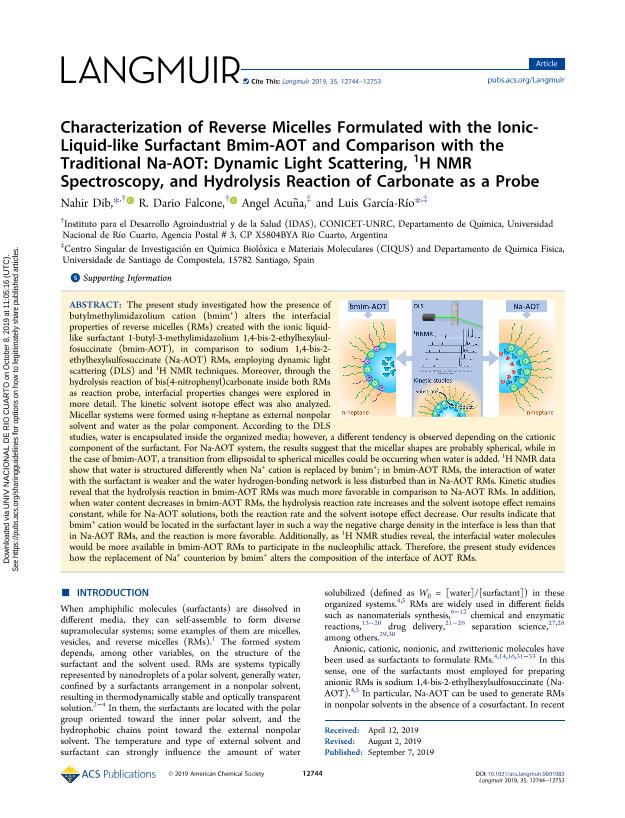Mostrar el registro sencillo del ítem
dc.contributor.author
Dib, Nahir

dc.contributor.author
Falcone, Ruben Dario

dc.contributor.author
Acuña, Angel
dc.contributor.author
García-Río, Luis
dc.date.available
2020-12-17T13:55:34Z
dc.date.issued
2019-10
dc.identifier.citation
Dib, Nahir; Falcone, Ruben Dario; Acuña, Angel; García-Río, Luis; Characterization of reverse micelles formulated with the ionic-liquid-like surfactant Bmim-AOT and comparison with the traditional Na-AOT: Dynamic light scattering, 1H NMR spectroscopy, and hydrolysis reaction of carbonate as a probe; American Chemical Society; Langmuir; 35; 39; 10-2019; 12744-12753
dc.identifier.issn
0743-7463
dc.identifier.uri
http://hdl.handle.net/11336/120734
dc.description.abstract
The present study investigated how the presence of butylmethylimidazolium cation (bmim+) alters the interfacial properties of reverse micelles (RMs) created with the ionic liquid-like surfactant 1-butyl-3-methylimidazolium 1,4-bis-2-ethylhexylsulfosuccinate (bmim-AOT), in comparison to sodium 1,4-bis-2-ethylhexylsulfosuccinate (Na-AOT) RMs, employing dynamic light scattering (DLS) and 1H NMR techniques. Moreover, through the hydrolysis reaction of bis(4-nitrophenyl)carbonate inside both RMs as reaction probe, interfacial properties changes were explored in more detail. The kinetic solvent isotope effect was also analyzed. Micellar systems were formed using n-heptane as external nonpolar solvent and water as the polar component. According to the DLS studies, water is encapsulated inside the organized media; however, a different tendency is observed depending on the cationic component of the surfactant. For Na-AOT system, the results suggest that the micellar shapes are probably spherical, while in the case of bmim-AOT, a transition from ellipsoidal to spherical micelles could be occurring when water is added. 1H NMR data show that water is structured differently when Na+ cation is replaced by bmim+ in bmim-AOT RMs, the interaction of water with the surfactant is weaker and the water hydrogen-bonding network is less disturbed than in Na-AOT RMs. Kinetic studies reveal that the hydrolysis reaction in bmim-AOT RMs was much more favorable in comparison to Na-AOT RMs. In addition, when water content decreases in bmim-AOT RMs, the hydrolysis reaction rate increases and the solvent isotope effect remains constant, while for Na-AOT solutions, both the reaction rate and the solvent isotope effect decrease. Our results indicate that bmim+ cation would be located in the surfactant layer in such a way the negative charge density in the interface is less than that in Na-AOT RMs, and the reaction is more favorable. Additionally, as 1H NMR studies reveal, the interfacial water molecules would be more available in bmim-AOT RMs to participate in the nucleophilic attack. Therefore, the present study evidences how the replacement of Na+ counterion by bmim+ alters the composition of the interface of AOT RMs.
dc.format
application/pdf
dc.language.iso
eng
dc.publisher
American Chemical Society

dc.rights
info:eu-repo/semantics/openAccess
dc.rights.uri
https://creativecommons.org/licenses/by-nc-sa/2.5/ar/
dc.subject
REVERSE MICELLES
dc.subject
BMIM-AOT
dc.subject
IONIC LIQUIDS
dc.subject.classification
Físico-Química, Ciencia de los Polímeros, Electroquímica

dc.subject.classification
Ciencias Químicas

dc.subject.classification
CIENCIAS NATURALES Y EXACTAS

dc.title
Characterization of reverse micelles formulated with the ionic-liquid-like surfactant Bmim-AOT and comparison with the traditional Na-AOT: Dynamic light scattering, 1H NMR spectroscopy, and hydrolysis reaction of carbonate as a probe
dc.type
info:eu-repo/semantics/article
dc.type
info:ar-repo/semantics/artículo
dc.type
info:eu-repo/semantics/publishedVersion
dc.date.updated
2020-11-05T18:32:26Z
dc.identifier.eissn
1520-5827
dc.journal.volume
35
dc.journal.number
39
dc.journal.pagination
12744-12753
dc.journal.pais
Estados Unidos

dc.description.fil
Fil: Dib, Nahir. Universidad Nacional de Río Cuarto. Instituto para el Desarrollo Agroindustrial y de la Salud. - Consejo Nacional de Investigaciones Científicas y Técnicas. Centro Científico Tecnológico Conicet - Córdoba. Instituto para el Desarrollo Agroindustrial y de la Salud; Argentina
dc.description.fil
Fil: Falcone, Ruben Dario. Universidad Nacional de Río Cuarto. Instituto para el Desarrollo Agroindustrial y de la Salud. - Consejo Nacional de Investigaciones Científicas y Técnicas. Centro Científico Tecnológico Conicet - Córdoba. Instituto para el Desarrollo Agroindustrial y de la Salud; Argentina
dc.description.fil
Fil: Acuña, Angel. Universidad de Santiago de Compostela; España
dc.description.fil
Fil: García-Río, Luis. Universidad de Santiago de Compostela; España
dc.journal.title
Langmuir

dc.relation.alternativeid
info:eu-repo/semantics/altIdentifier/doi/http://dx.doi.org/10.1021/acs.langmuir.9b01083
dc.relation.alternativeid
info:eu-repo/semantics/altIdentifier/url/https://pubs.acs.org/doi/10.1021/acs.langmuir.9b01083
Archivos asociados
